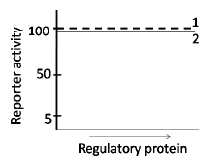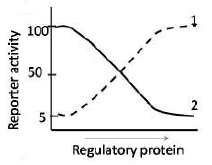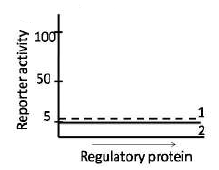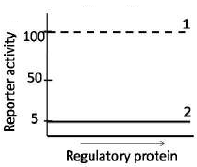 Multiple Choice Questions
Multiple Choice QuestionsIn a type of signal transduction pathway, ligand binding to a receptor triggers activation of a receptor-associated kinase. This kinase may be an intrinsic part of the receptor protein or tightly bound to the receptor. Receptors in which the tyrosine kinase is an intrinsic part of it's polypeptide chain is an intrinsic partof it's polypeptide chain are called the receptor tyrosine kinase (RTK). Which one of the following statements regarding RTK is INCORRECT?
All RTKs have three essential components: an extracellular domain containing ligand binding site, a transmembrane domain and a cytoplasmic segment that includes a domain with protein kinase activity.
Most RTKs are monomeric and ligand binding to the extracellular domain induces formation of receptor dimers.
All cytokine receptors belong to RTKs and cytokine binding activates tyrosine kinase and receptor dimerization.
Ligand binding to RTk leads to autophosphorylation of the protein tyrosine kinase in the cytoplasmic domain. The activated kinase then phosphorylates several tyrosine residues in the receptor's cytoplasmic domain.
C.
All cytokine receptors belong to RTKs and cytokine binding activates tyrosine kinase and receptor dimerization.
Among the given statements, statement 3 is the incorrect option.
In all organisms, it is critical that replication initiation be tightly controlled to ensure that chromosome number and cell number remain appropriately balanced. Given below are several statements regarding regulation of replication in E. coli.
A. Hemimethylation and sequestration of oriC (origin of replication) by a protein called SeqA prevents initiation of replication.
B. Availability of DnaA protein is an important requirement for initiation of replication.
C. The ratio of ADP : ATP is important as high level of ADP is required for initiation of replication.
D. Recruitment of Hda protein by sliding clamp inhibits ATP hydrolysis required for initiation of replication.
Which of the above statements are NOT true?
A and B
B and C
C and D
D and A
In E. coli, though DNA Polymerase I (Pol I) plays an essential role in the replication process, it is not the major polymerase. Instead, the enzyme responsible for advancement of replication fork is Pol III. From the four DNA structures (A, B, C, and D) given below, students made several interpretations about the shorter arm being extended by Pol I and / orPol III.
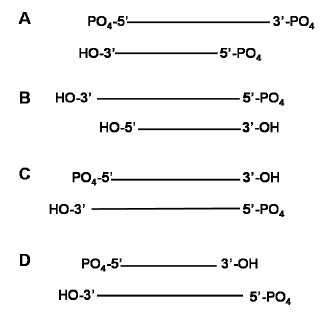
Which one of the interpretation written below is correct?
A will be extended by Pol III but not by Pol I
Neither B nor C will be extended by either Pol I or Pol III.
C will be extended by both Pol I and Pol III.
D will be extended only by Pol I, but not by Pol III.
tRNA genes of a gram positive bacteria were sequenced. While some of the genes possessed sequence corresponding to the -CCA end of the tRNA, others did not. Interestingly, even the genes that lacked the sequence corresponding to the -CCA end of the tRNA were found to code for a functional tRNA. This is because
the -CCA end in the tRNA is not essential for its function.
the genes that do not possess sequence corresponding to the -CCA ends of the tRNA are repaired prior to their transcription.
the -CCA end is added to the tRNA during their maturation.
the primary transcripts of the genes lacking sequence corresponding to -CCA end are subjected to g-RNA mediated editing prior to their maturation.
A construct (shown below) was generated to access the activity of bidirectional promoter (A and B) which has a common regulatory DNA element (X). The construct was used to transform E. coli.

The activity of the promoter (as shown in the graph below) is recorded in the presence of increasing levels of an E. coli encoded regulatory protein which binds to DNA element X.
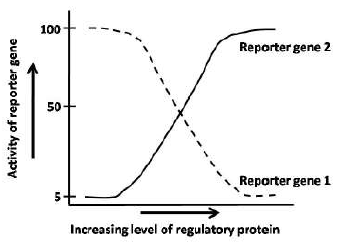
The above experiment is repeated in a mutant E. coli with mutation which abolishes binding of the regulatory protein to element X. Which one of the following graphs best depicts the activity of the reporter genes in the mutant strain?
